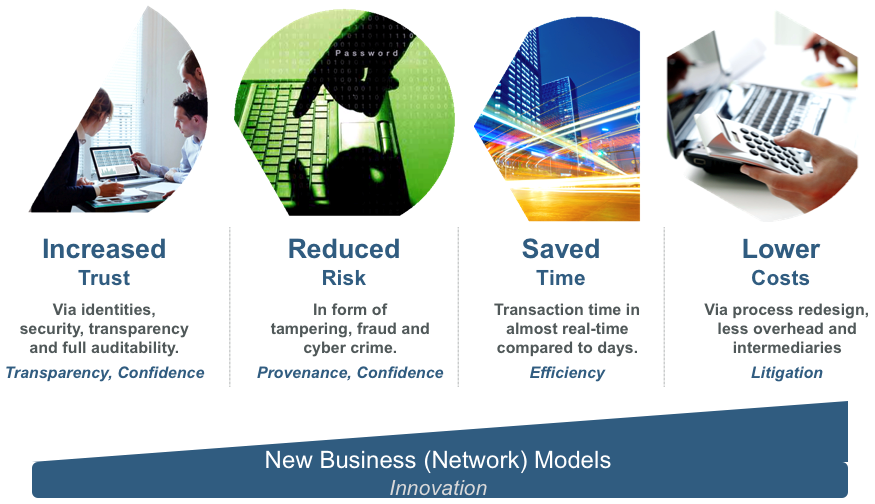Government
Blockchain Project Roadmap
16 May, 2019 | Written by: Ulrich Schimpel
Categorized: Blockchain | Government
Share this post:
Over the past month, Stacy and her peers – all department head of a large government agency – have been frequently exposed to dozens of articles and events around blockchain, talking about the great potential it could unlock in the government domain. Yet, she and her colleagues are struggling to see a feasible approach to get into this topic. Their preference would be for a small first exposure to this new technology, but they also understand that blockchain is most beneficial for collaboration between (autonomous) organizations.
Blockchain is said to be a team sport … but which partner should I choose and how should I get started?
Stacy is confronted with finding answers to these three key questions:
- What are expected benefits from blockchain projects and when will they materialize?
- Which use cases are good for starting out with, whilst still leverage some these benefits?
- Do I need to start with an (external) partner, and who would that be?
Why Blockchain
The benefits and their materialization over time depend on where and how blockchain is applied (see Figure 1).

Figure 1: Evolution of benefits and addressed topics within a typical blockchain project
One can distinguish three basic stereotypes of Blockchain projects:
- New Business (Network) Models usually come along with a new ecosystem and new technology, aka “green field approach”. All benefits from transparency to lower costs materialize quickly because the entire ecosystem is not limited by an existing (legacy) environment or by lock-in effects in form of technology investments and widely adopted (suboptimal and evolutionary) processes. Typical challenges for completely new business models based on blockchain are the development of the market and potential legal clarifications, due to the pioneer character of such endeavors.
- Modernizing an existing Ecosystem via blockchain technology often starts with a core team of selected forward-thinking ecosystem partners and typically requires the (temporary) creation of a “Blockchain process” in parallel to the existing processes … simply because the rest of the ecosystem will continue to operate in the existing (legacy) world.
In other words, a shadow process is employed which generates additional costs and effort in the beginning. Ideally, such a modernization “Blockchain process” yields non-monetary benefits from the very beginning, usually starting with the benefit of better visibility and increased trust. Over time the trust and visibility allow the reduction of the existing risk measures, and the Blockchain project starts yielding measurable benefits in terms of saved time and costs.
The advantages are little or no legal issues due to following established practices and most importantly the strong influence and freedom to shape the ecosystem in its early stages. - Joining an existing (Blockchain) Ecosystem usually combines the advantages of the above project stereotypes, i.e. monetary and non-monetary benefits by moving to the new technology and avoiding “shadow processes”. Depending on the time of onboarding one still has good impact on how the ecosystem will be evolving.
- In some use cases, one can exclusively replace the underlying (inefficient) technology with a better suited blockchain system. In this case, the existing processes themselves are not affected but simply accelerated and additional features and processes are enabled. In this case, the monetary and non-monetary benefits also materialize rather quickly. The advantage and disadvantage is, that the existing processes are not altered which can spare a lot of effort but will also leave some optimization potential untapped.
In contrast to New Business (Network) Models where a monetized benefit can show almost from the very beginning, the usual context of a blockchain project for governments is Modernizing an existing Ecosystem which requires the creation of a “Blockchain process” in parallel to an existing process. In other words, a shadow process is employed which generates additional costs and effort in the beginning. Ideally, this “Blockchain process” yields non-monetary benefits from the very beginning, usually starting with the benefit of better visibility and increased trust. Over time the trust and visibility allow the reduction of the existing risk measures, and the Blockchain project starts yielding measurable benefits in terms of saved time and costs.
How to get started?
The first essential point is to develop a valid blockchain use case. Given the distributed, cross-organizational nature of blockchain Stacy should already start by thinking beyond her own organization. What are my biggest pain points when dealing with external parties? Where are interactions with partner organizations inefficient or lacking transparancy?
Pain Points are a good start:
Where does my organization face a lack of transparency or tremendous effort in the interaction with external parties?
A design thinking workshop with participants from various departments, roles and even (partner) organizations has proven to be a highly effective and efficient approach to elaborate a user-centric, valuable and feasible first project (aka “minimal viable product” or MVP). The workshop yields valuable customer stories, priorities, relevant partners and other stakeholders that are essential ingredients to turn the MVP into a success story with a larger perspective and business context.
The MVP serves as a first, valuable and light-weight test balloon to get hands-on experience with the technology and its benefits, limitations and consequences for employees and processes. It also yields concrete results that support a quantitative evaluation whether and how to continue with the use case at hand.
Why IBM
IBM offers a unique combination services, technology and skills:
- Conduct a Design Thinking Workshop with an organization and optionally also good and motivated partner(s) to elaborate a user-centric, feasible and valuable blockchain use case.
- Build a “minimal viable product” for the blockchain use case
- Offer strategic, industry-specific and technical advice to formulate and plan a mid-term blockchain road map
- Successfully implement
- Consult and support the organization and its partners in building a feasible business model, ecosystem and governance approach.
Ask yourself
Where do you spend a considerable amount of time in the interaction with external parties? Where would more transparency already provide a significant value-add to my daily exchange with partner organizations today? These paint points are a good starting point to elaborate a meaningful MVP to get hands-on experience and quantitative results from applying the blockchain technology in my organization.
This is the sixth in a series of blog posts on the ways in which Blockchain can help Governments deliver better services for citizens. The previous post can be found here.

Federal CTO, IBM CH
Six steps to solving the sustainability data challenge
Six steps to solving the sustainability data challenge Over the past 18 months, uptake of some of the United Nations sustainable development goals has accelerated, with some very prominent global enterprises making commitments to environmental and social change. The target date cited by these announcements is 2030. That gives businesses less than nine years […]
Burberry supports IBM interns to develop prototype system for product traceability
Burberry’s technology experts were keen to share their knowledge with a younger generation. With coaching from Burberry, students from IBM’s Extreme Blue internship program developed a prototype system that may help to improve product traceability and provide consumers with deeper insights into a product’s lifecycle. Burberry’s commitment to sustainability is long-standing, grounded in the […]
Code@Think – Build the skills you need to emerge smarter
Build the skills you need to emerge smarter at Code@Think If we’re going to emerge smarter from the challenges 2020 has thrown us, we’re going to need the best technology available – and, more importantly, the skills to manipulate it. We’re living through an era of transformation like no other. We’ve all experienced phenomenal change […]


